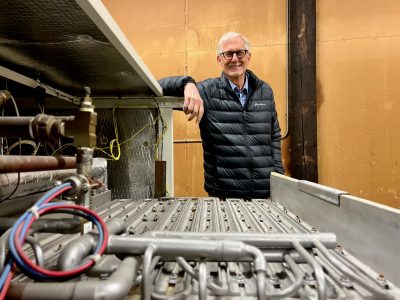
Michael Burz, EnZinc co-founder and president.
Advanced batteries are the linchpin of the energy transition, from stabilising energy grids to powering electric vehicles. But the critical minerals needed to produce them are sourced with limited transparency or accountability to workers, communities, or the environment. Recycling and reuse remain vastly underdeveloped, risking a repeat of fossil fuel-era harms through excessive extraction and mounting waste. Imagine if every battery were designed for maximum efficiency, reused before it was recycled, and re-entered the supply chain without ever becoming waste. By turning to circular solutions, we could reduce resource pressure and avoid the looming bottlenecks threatening this booming sector. The good news: entrepreneurs are embedding circularity throughout the battery lifecycle. This is what we’re building at New Energy Nexus. Our Just Batteries initiative has supported 116 startups across the battery value chain—from extraction to recycling—while shaping an innovation ecosystem rooted in equity, access, and sustainability. Here’s a closer look at some of the solutions we’re surfacing around the world.
1. Batteries aren’t designed for circularity
Solution: Upstream tech making batteries safer and recyclable
Most batteries today are built for cost and performance, not for reuse, disassembly, or recycling. This design blind spot leads to costly, waste-heavy end-of-life challenges. GRST presented its solution at our Thai team’s Decarbonize Thailand Symposium 2025: a water-based binder replacing toxic PFAS in lithium-ion batteries, which enables clean disassembly and water-based recycling without sacrificing performance or cost. Their tech has been proven at 1 GWh commercial scale, making it a practical upgrade for manufacturers and recyclers alike.
2. Second-life opportunities go untapped
Solution: Modular systems that extend battery life
Used EV batteries still hold significant energy, but most are retired prematurely. Without clear reuse pathways, valuable materials are lost too early. Norwegian startup Evyon gives these batteries a second life. Their modular energy storage systems repurpose EV packs into plug-and-play units for buildings and grids, already deployed in six countries and reducing emissions by over 90% compared to using new batteries. Evyon won 2024 LGES Battery Challenge, co-hosted by LG Energy Solution and NEX China—along with one other enterprise we’ll talk about later.
3. Recycling is inefficient and environmentally risky
Solution: Clean recovery of critical materials without toxic waste
Traditional recycling methods rely on high heat or harsh chemicals and generate hazardous byproducts like black mass. It’s costly, emissions-heavy, and difficult to scale. Renewable Metals, led by Luan Atkinson, developed an alkali-based process that recovers over 95% of battery minerals without generating toxic waste. Presenting a safer, cleaner, and more economically viable system for the future of battery recycling, Renewable Metals won the first Supercharge Australia Innovation Challenge, our collaboration with EnergyLab.
4. Battery lifespan is too short
Solution: Smarter charging that prevents degradation
Premature degradation drives up demand for raw materials and puts pressure on manufacturing and disposal systems. Thus, extending battery life is one of the most immediate ways to reduce resource consumption. US-based Iontra came up with a charging technology that adjusts in real time to battery conditions, significantly reducing wear and tear. Their solution extends battery life and improves performance, helping keep batteries in use longer and out of landfills. Iontra shared the win with Evyon at the 2024 LGES Battery Challenge, both receiving cash prizes and support from LG Energy Solution in their pilot projects.
5. We rely too much on critical minerals
Solution: Mineral-free storage that complements batteries
Building more batteries isn’t the only answer. To stabilize clean energy systems long-term, we also need alternative storage options that reduce pressure on mineral supply chains. California-based Sperra, which earned a US$500,000 grant from the CalSEED Prototype Awards, is developing subsea pumped hydro storage using 3D-printed concrete spheres. Deployed on the ocean floor, their system stores and releases energy without using a single battery cell, offering a durable, scalable complement to electrochemical storage. Also in the Golden State, Enzinc is rethinking battery chemistry altogether. Instead of lithium or cobalt, they’re developing high-performance batteries using zinc: a material that’s safer, more abundant, and fully recyclable. Their technology is designed to power everything from e-bikes to home storage, expanding access to affordable, sustainable energy storage without deepening reliance on critical minerals.
Powering the shift to circularity
There are more entrepreneurs around the world who could make battery circularity a reality, but they need a strong ecosystem backing them up and scaling their impact. We’re proud to support them, and we invite you to join us in powering what’s next. If you’re a clean energy entrepreneur with a unique battery solution, check out our programs. For potential partners and investors interested in getting involved, find out how.